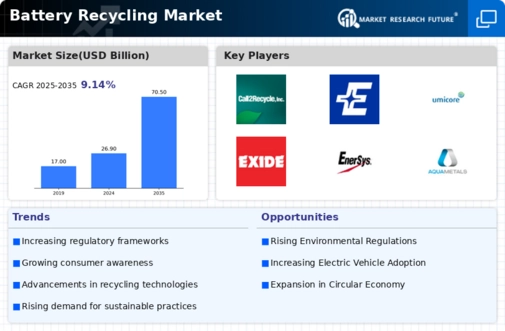Battery Recycling Size
Battery Recycling Market Growth Projections and Opportunities
Their changes are dictated by various market factors that impact the working of this battery recycling. Some of the prime causes are increasing international contention regarding e-waste or electronic waste and environmental pollution due to unwarranted disposal of batteries. As electronic items and electric vehicles grow in numbers, the issue of end-of-life batteries also rises, so people need sustainable recycling methods. A core factor influencing the direction of development of the battery recycling market is an environmental awareness among consumers and regulating institutions. Government rules and policies have a vital role in determining the market avenues of battery recycling. Various nations have come up with tough laws to ensure appropriate management of batteries and proper recycling aimed at addressing the pollution that results from improper disposal. This legal framework encourages the behavior of regulation that influences industry performance, compliance, and the development of certified recycling facilities. The dynamism in their adoption continues to be one of the biggest drivers shaping market dynamics as players take more environmentally responsible approaches. Three critical factors influencing market dynamics include technological advancements in battery recycling processes. With the increasing need for efficient and responsible approaches to recycling, there is constant innovation allowing more materials recovery from batteries. Technological enhancements in sorting, shredding and separation allow enhanced extraction of valuable materials like lithium, cobalt and nickel hence increasing recyclability efficiencies. Many of these technologies are not only environmentally responsible but also affect the competitive dynamics in the battery recycling market, as firms invest into advanced technology. Considerations such as costs are important in the battery recycling market. The expensive prices on critical metals in batteries like cobalt and lithium spark recycling endeavours. Moreover, the economic feasibility of recovering these important materials contributes to waste management that is beneficial for sustainability and makes battery recycling a source of raw material with strategic significance thus reducing reliance on conventional methods in mining. The main reasons why battery recovery is attractive from an economic perspective include the associated cost factors that are often linked to material recycling. The field of battery recycling is expected to grow and expand as the market develops for electric cars and renewable energy storage solutions.













Leave a Comment